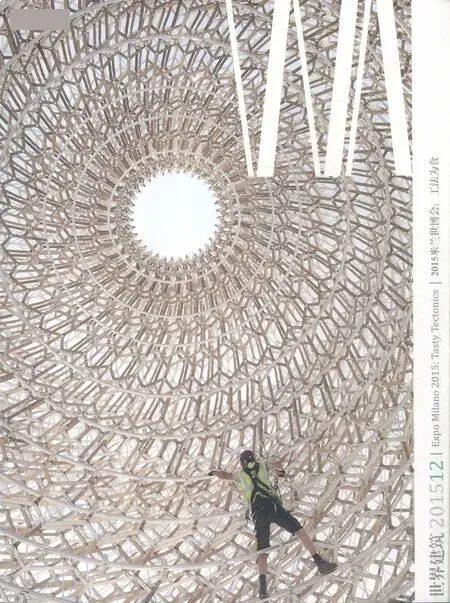个人活动:爱沙尼亚馆
建筑设计:KTA建筑事务所
Architects: Kadarik Tüür Arhitektid
个人活动:爱沙尼亚馆
Individual Activities: Estonian Pavilion
建筑设计:KTA建筑事务所
Architects: Kadarik Tüür Arhitektid
1 概要
爱沙尼亚馆的命名——“——的展廊”,贴切地概括了这座场馆的气质。更广泛来讲,这一命名体现了这样一个概念:爱沙尼亚是一个小而充满活力与智慧的国家,每个公民的自主性以及境外投资和国际合作,都会影响它运行的方式。
“——的展廊”是一个开放的创意平台,而富有创造性的爱沙尼亚人将会赋予其生命力与内涵。该场馆的建筑设计希望为多样化的表演、展览、活动与讲演营造最佳环境,并以此作为整体设计的基础。爱沙尼亚馆并非诞生于“为形式而创造形式”的动因,而是作为一个承载框架,进而以展览内容赋予建筑生命。
该场馆的设计哲学与北欧斯堪的纳维亚人的民主价值观紧密相连——尊重每一个体自我表达与创造的权力。实际上,这座场馆正如同爱沙尼亚——一个小而充满活力的民主国家——的微缩模型:它的发展与一切在那里生活、游访的人息息相关。伴随着新鲜的想法和现代的应用程序,集体创意成果在这里成为现实。爱沙尼亚馆的最终形态将由爱沙尼亚创意群体与所有的参观者共同塑造,参观者同时沉浸于自然、科技、文化与美食之中,来完成对爱沙尼亚的全方位体验。
更广泛来讲,一个开放的平台意味着透明而灵活的商业环境——它迎接崭新的原创,也尊重与全球进程的呼应和连接。这一概念充溢于令爱沙尼亚引以为豪的活动和创意中,在展馆三层的旋转式展台呈现的多个主题展览中,观者的视角得到放大:这里提供了一个单独的展区,集中展示创新公司、地产提案、绿色乡企、乡村旅游、创意行业与艺术作品。通过这些展览,我们试图将讲述的故事与展馆的统一主题紧密关联——充满自然、创造与革新的爱沙尼亚。
场馆同时也切合了世博会的主题“滋养地球,生命之源”。通过绿色建造和建筑模块的后续回收利用,向爱沙尼亚有机食材和杰出厨师致意的食物项目,以及在展馆首层、三层展开的详尽展览,爱沙尼亚的故事从自然之中孕育,进而借助当代科技及设计被赋予新颖形式与实用功能。
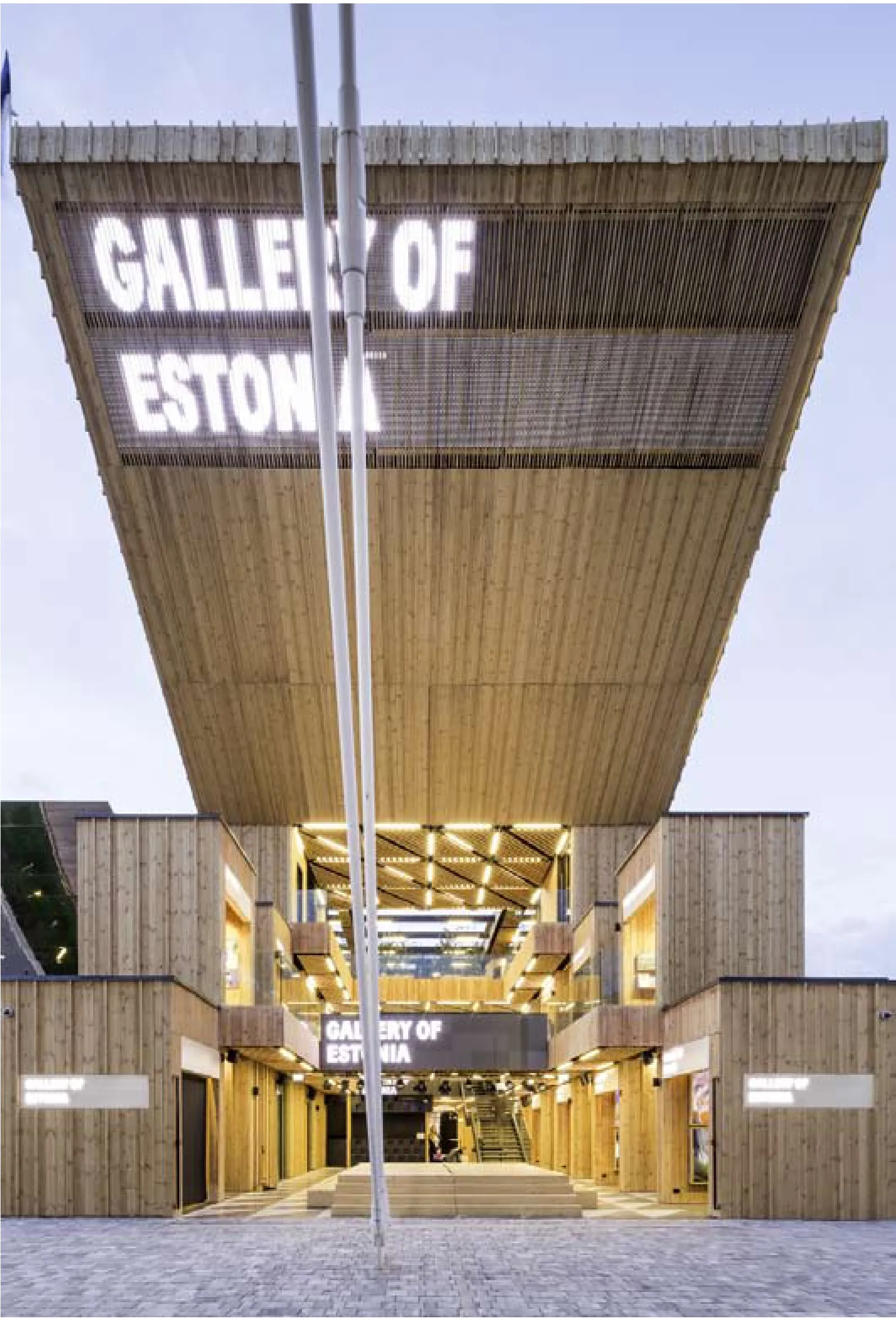
1 外景/Exterior view
宾客们在场馆中可以自由选择专属的活动、陈列抑或故事来编织每个人独一无二的爱沙尼亚体验。最重要的是,每个人进入场馆后都将拥有难以忘怀的记忆——温暖、开放而友善的氛围,包裹着使人心情激昂的现实陈列、令人目不转睛的故事讲述、叫人耳界大开的自然之声,在这里可以看到科技的简洁之美,也能在品尝美味的同时欣赏曼妙的音乐。
2 场馆设计详述
2.1 核心构想
爱沙尼亚馆被设想为一个容纳表演活动和展示创意成果的多功能空间环境。空间意味和氛围的构想首要来源于发生于其中的空间行为与事件(如音乐会、展览、讲演、会议等)。
而场馆的建筑学准则则是营造出明确的空间特征,以使参观者从中感知到爱沙尼亚的真正面貌。这座场馆将被建造为一座充满自然与创意的展廊。
2.2 布局与功能
展馆由一系列错列叠置的方体“鸟巢箱”组成,构成了朝向俄罗斯国家馆和沿组团内道路延展的主要体量。
每个“鸟巢箱”都是一个小而独立、如同包厢一般的包裹式挑高空间。
在世博会结束后,这些模块组装单元将被运回爱沙尼亚,并用于儿童游戏场、自然观景处或公交站亭等。理论上,将整座爱沙尼亚馆拆除并在运回国内后完全原样重组具有实现的可能性。
“——的展廊”面向东西向世博轴的南向主入口被置于一个巨大高耸的悬挑雨棚之下,直接呈现出宽敞的内部空间,为游客带来极具冲击力的视觉体验。次入口还有两个:一个连接北部广场,一个在箱体之间通向街道。
凭借其开放性,爱沙尼亚馆在表达对世博游客盛情邀请的同时,也暗示了爱沙尼亚人对创新、对世界的开放心态。
建筑共有3层。首层包含厨房及附属部分、酒吧和纪念品柜台,“鸟巢箱”形成的舒适“包厢”式空间与同层的其他展陈空间一起,为参观者了解爱沙尼亚提供了充足的信息,来满足游客对爱沙尼亚的认知渴望。
从东西大道的主入口一进入,是一个由1.2m×1.2m模块组成的舞台空间,这部分空间可以根据需求进行灵活调整、重新组合。
通往二层的交通方式包括沿建筑西立面展开的狭窄楼梯和位于建筑中央宽敞的两段式单跑楼梯。在二层中,主要的展区聚焦于爱沙尼亚及其企业和行业部门,向观众深入介绍各行业成就。与之类似,位于同一层中的“黑麦吧”详细讲述了爱沙尼亚生产洁净黑麦的故事。
三层的空间基调由屋顶花园塑造,该花园中种植了爱沙尼亚特有的植被、树木种类。植物种植于独立容器中,相互之间还预留了漫步和闲坐的空间,邀请参观者在这里停留,甚至鼓励人们进行野餐——地面层还有售卖外带野餐套餐的地方。
三层的交通连接通过北侧的多个楼梯间实现。紧邻北侧背立面的广场上方,布置了容纳小型会议的休息室,其家具陈设柔软舒适,并提供了望向三层花园的观景视角。
建筑总共的3层空间全部通过楼梯间提供了方便的交通,主要楼梯向任何人开放,而背面的楼梯承载疏散功能或被员工使用。此外,场馆中将安装一个升降电梯来满足无障碍需求。
2.3 室内建筑环境
(1)室内建筑概念
若从更大范围的东晋君臣的精神生活看,因佛学在渡江之初便开始深入上层社会尤其皇帝的日常生活,佛学对东晋儒学的挑战更是空前与令人触目惊心的,其已直接渗透到了东晋皇族教育。上文已梳理了玄学对东晋儒学的挑战及其世人的应对,下面再重点分析佛学对东晋时期皇帝教育的侵蚀及其江左君臣的呼应:
场馆的室内空间设计基于内外部环境的综合考量,并希望打破内外部建筑环境之间的边界壁垒。这种统一性通过木材表面的重复使用进行强调,沿建筑的像素化结构创造出韵律性的重复。空间设计要尽可能容纳更多功能,因此可能会根据需求和实时功能进行重新布置。室内设计以简洁为主,从而为广泛使用在展馆中的LED展示屏幕提供谦逊、低调的背景。
基于空间理性化的想法,模块木盒子中将应用许多标准设计产品:秋千模块、二层的LED屏幕模块、三层的旋转式展台模块、会议室模块和一系列附属物品。
(2)空间和功能模块概念
首层的公共开放区域,一部分布置了绿色盆栽植物,能够承载多功能的活动,并提供灵活调整的可变性。该公共区域被规律布置的两种箱体环绕围合,即充满活力的秋千“鸟巢箱”与具有LED屏幕的永久展览“鸟巢箱”。靠近附属功能区的水池,还为游客提供了可饮用的纯净水。
二层的空间则更为私密。黑麦主题吧与吊椅休息区位于中央,结合几组桌椅和吧台凳,为谈话和餐饮活动提供了便利空间。空间逻辑在一层得到延续——仍然以展陈、秋千箱体交替出现的方式进行布置。
三层的屋顶花园是开放的,其边缘布置了供嘉宾和会晤使用的会议室。花园中的植物种植槽之间设有座椅模块和提供柔和暖光的照明岛。屋顶花园周围布置了带雨棚的展廊,通过它连接办公/会议区域。
角落、缝隙的概念和私密箱体的概念在整座建筑中也通过灯光设计得以强化,这一照明系统还能够根据自然光状况进行自动调节。□(陈茜 译)
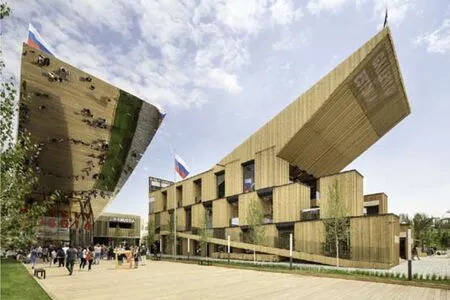
2 外景/Exterior view
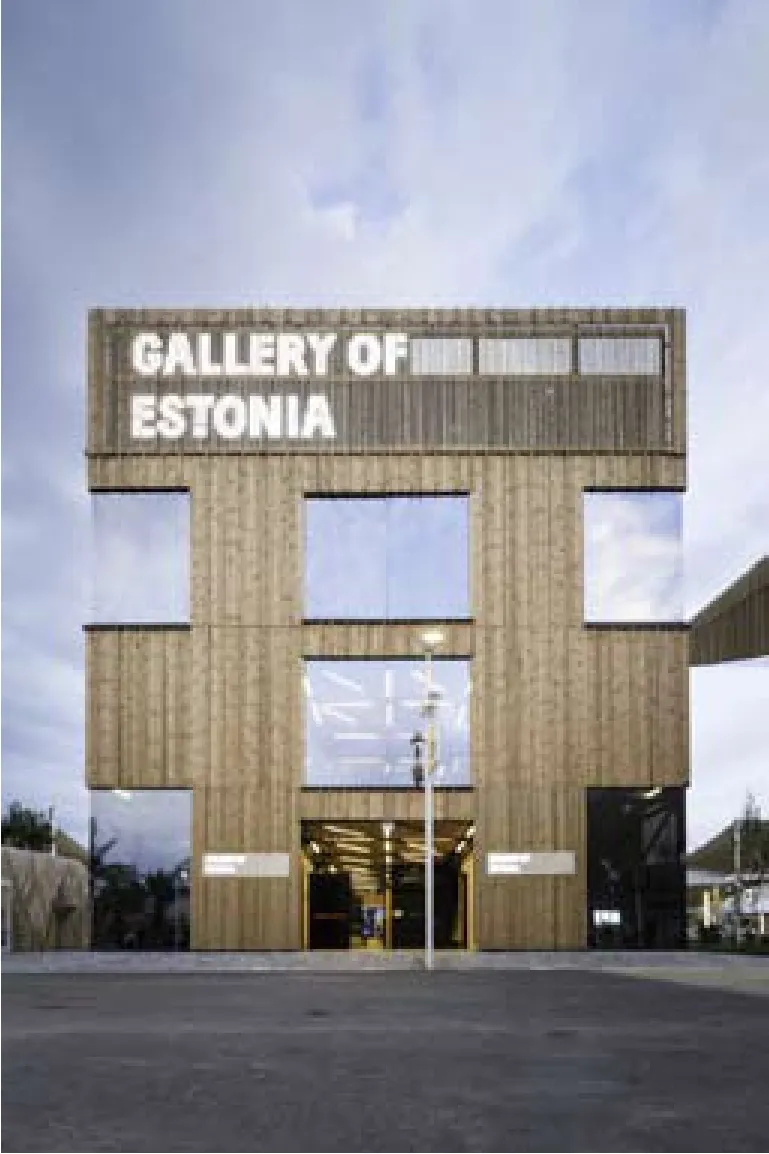
3 外景/Exterior view
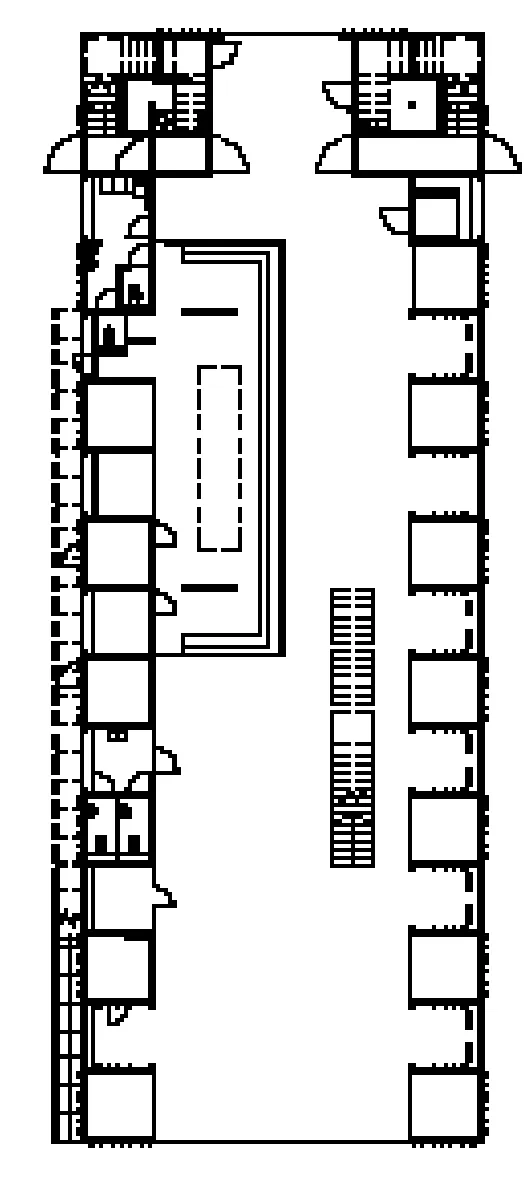
4 首层平面/Floor 0 plan
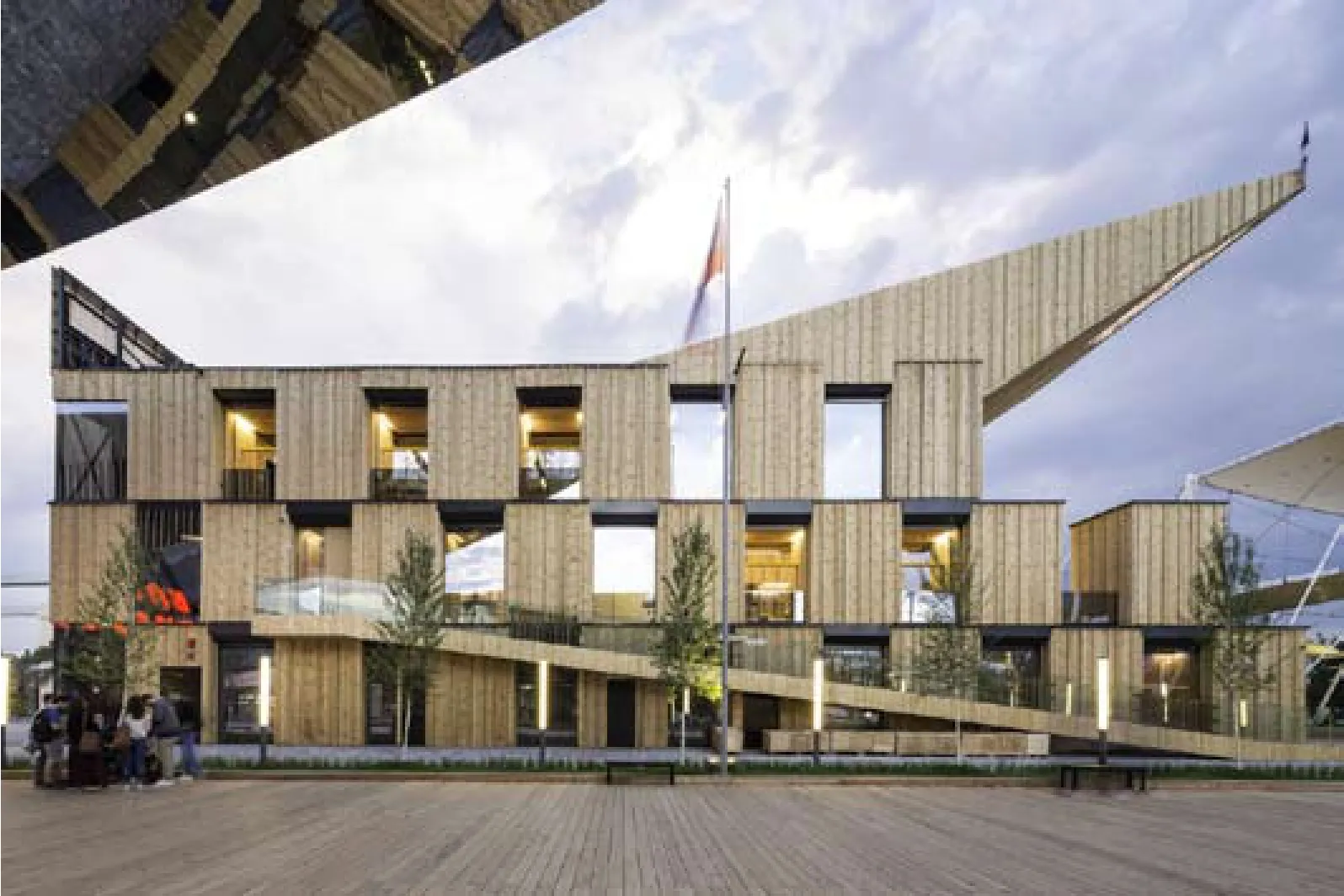
5 外景/Exterior view
1 Introduction
The title of the Estonian pavilion, "Gallery of _", symbolises the nature of the entire pavilion and, more broadly, the idea that Estonia is a dynamic and smart small country: every citizen's initiative, every foreign investment, as well as international collaborations and foreign investors, affect how it fares.
"Gallery of __" is an open platform for creative Estonian people, who will fill it with life and content. The architecture of the entire pavilion is created based on the idea that it should provide the best conditions for holding various performances, exhibitions, actions and presentations. Rather than form for form's sake, the pavilion is a framework for content that will bring the building to life.
More broadly, an open platform also means a transparent and flexible business environment that favours new initiatives and responsible connections to global processes. Upon closer inspection, this idea informs all the activities and initiatives that we are proud of Estonia. We also wish to zoom in on the 2nd floor of the pavilion in rotating themed exhibitions: a separate exhibition area will be provided here for the focused presentation of innovative companies, e-state solutions, green rural enterprise, rural tourism, creative sectors and fine arts. All presented themes and stories told by us will be intertwined with the pervasive theme of the pavilion: Estonia as a country of nature, creativity and innovation.
The pavilion will be linked to the main theme of the Expo "Feeding the Planet, Energy for Life" through a number of strategies: the green executionof the pavilion and the subsequent recycling of its modules, a food programme paying tribute to organic Estonian raw ingredients and talented chefs, and the permanent exhibition recounting on both the ground floor and 2nd floor; Estonia's naturalborn stories are given a novel form and functionality by means of contemporary technology and design.
Guests at the pavilion have free choice of what activities, facts or stories are to be woven into their personal experience of Estonia. The most important thing that anyone entering the pavilion should remember is a warm, open and hospitable atmosphere, laced with exciting facts, gripping stories, rare sounds of nature, simple yet elegant technology, tasty bites and good music.

6 外景/Exterior view
2 Description of the pavilion
2.1 Central idea
The pavilion is created to be a multi-functional environment for holding performances and presenting creative output. The space will draw its meaning and atmosphere primarily from events held at the pavilion (concerts, exhibitions, presentations, conferences etc.).
The architectural premise for the pavilion will be a space with a clear identity, enabling visitors to get an idea of what Estonia is about. The pavilion is structured as a gallery of nature and creativity.
2.2 Description of the layout and functionalities
The pavilion is composed of "nestboxes" stacked off-centre like cubes, forming the main volume of the building towards the Russian pavilion and along the side of the road inside the quarter.
A "nestbox" is a high room creating a chamberlike, sectioned-off area of space.
After the end of the Expo, these modularassembly elements Could be used as children's playgrounds, natural viewing points or bus stop shelters. Theoretically, it will be possible to dismantle the entire Estonian pavilion and to reassemble it in exactly the same form in another location.
The main entrance of "Gallery of_" from Decumanus opens towards the south under a high, lofty awning, which along with the spacious interior creates a powerful experience. Additionally, there will be entrances from the plaza to the north and between boxes from the street.
With its openness, the pavilion both invites Expo visitors and alludes to Estonians' openness to innovations and the world.
The building has three floors. The ground floor houses a kitchen with ancillary facilities, bars and a souvenir stand. Furthermore, "nestboxes" form cosy "compartments", which together with the rest of the exhibition space on the ground floor provide visitors with an opportunity to quench their thirst for information about Estonia.
Immediately upon entering from Decumanus, there is an area planned for a stage which, consisting of 1.2 ×1.2m modules, will be flexible and capable of being readily re-arranged as needed.
Access to the first floor will be provided by a narrow stairway rising along the west side of the building and an airy double-flight stairway at the centre of the building. On the first floor, the main exhibition area profiles Estonia, our entrepreneurs and sectors, where visitors will be able to explore in-depth sectoral achievements. Similarly, the first floor will house a "rye bar" recounting the story of Estonia as a unique country producing clean rye.
The second floor houses a roof garden where plants and trees characteristic of Estonia set the tone. Plants are placed in dedicated containers with space in between for walking or sitting, inviting visitors to also have a picnic if they so desire, with a picnic set bought from the ground floor to take away.
Access to the second floor is provided with staircases on the north side of the building. Adjacent to the rear northern side of the building above the small plaza, a lounge has been planned for holding business meetings for a smaller group of people in a cosy setting on soft furniture with a view of the garden on the second floor.
In addition, the second floor houses utility rooms and facilities for the staff and management of the pavilion.
All three floors are inter-connected by stairs, with the main stairs open to all and the rear ones used as escape stairs or by staff moving between various floors. Furthermore, a platform lift will be installed in the building for handicapped persons.
2.3. Interior architecture
(1) Interior architecture concept
The interior design is based on a single comprehensive scheme for both exterior and interior spaces, doing away with boundaries between the two. Comprehensiveness is emphasised by copious use ofwooden surfaces, creating rhythmic repetitions along with the pixel structure of the building. The design of the space is meant to be as multi-functional as possible, so that it may be re-arranged according to need and the programs taking place at the pavilion. The interior design will be simple and intended as a neutral backdrop for the widely used LED-screen presentation space in the interior.
Based on the rationale for the space, wooden box modules will employ various standard designs: swing module, presentation modules with LED screens on floor one, rotating exhibition module on floor two, conference room module and blocks of ancillary facilities.
(2) Concept for spatial and functional modules
The open general area on the ground floor with a green counter of potted plants creates a fresh and flexible space to accommodate various program events. The general area on the ground floor is bordered by rhythmically alternating energy swing nests and permanent exhibition nests with LED screens. Near the block of ancillary facilities, there are drinking fountains of clean water for visitors.
First floor provides more privacy. In the middle, there is a rye-themed bar and an area with suspended chairs for hanging out, complemented by groups of tables with bar stools for conversation and supporting food or drink. The spatial rationale of floor one continues, with exhibition space alternating with private energy swing nests.
The roof garden on the second floor is open to all interested visitors; it is lined up with conference rooms for invited guests and meeting appointments. Between plant boxes in the roof garden are modular areas for sitting and an oasis with a dime and warm lighting design. The roof garden is surrounded by a gallery with an awning, giving access to the block of offices and conference rooms.
The concept of nooks and crannies and of private nests for the entire building will be supported also by the lighting design for the pavilion, which will be automatically adjustable according to the natural night / day light conditions.□
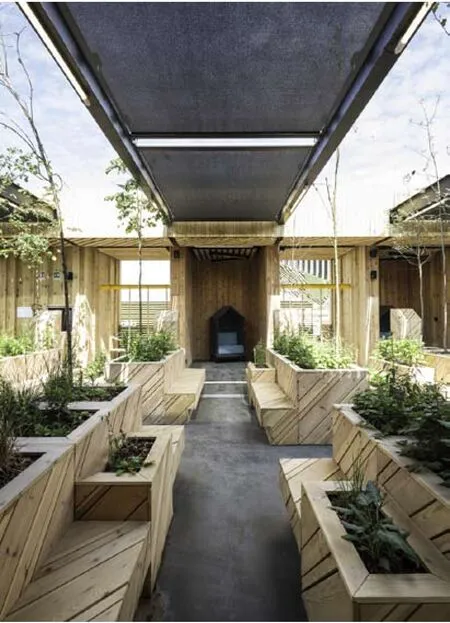
项目信息/Credits and Data
初步设计/Preliminary Design: Kadarik Tüür Arhitektid OÜ (Ott Kadarik, Mihkel Tüür, Priit Hamer, Kadri Tamme, Liis Mägi, Tanel Trepp, Kristi Tuurmann)
平面设计/Graphic Design: Uku-Kristjan Küttis, Kaarel Kala, Alari Orav AKU
近期阶段/Recent Stages: Kadarik Tüür Arhitektid OÜ - Ott Kadarik, Mihkel Tüür, Priit Hamer, Kadri Tamme, Liis Mägi客户/Client: EAS
施工设计/Construction Design: Civen OÜ
承建方/Builder: Redaelli Costruzioni S.p.A.
结构设计/Structural Design: Civen OÜ
使用面积/Gross Useable Floor Space: 1200m2
项目开始/Start of Work: 2013
项目结束/Completion of Work: 2015
结构/Structure: 钢结构/Steel
楼板/Floor: 混凝土,钢结构/Concrete, steel structure
墙面层/Walls Surfaces: 木质/Wood
摄影/Photos: Filippo Poli, 张璐/ZHANG Lu(fig.10)
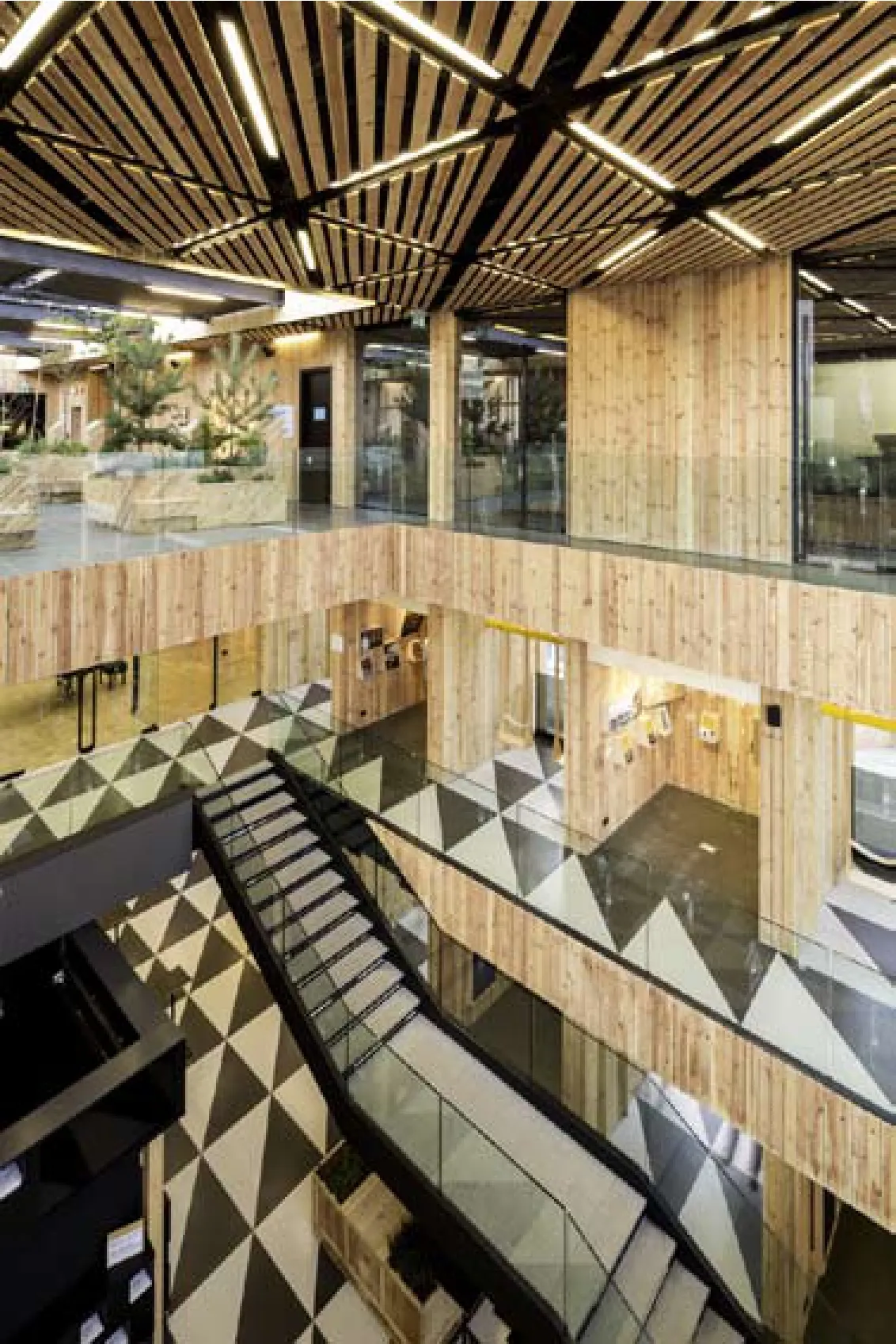
9 内景/Interior view
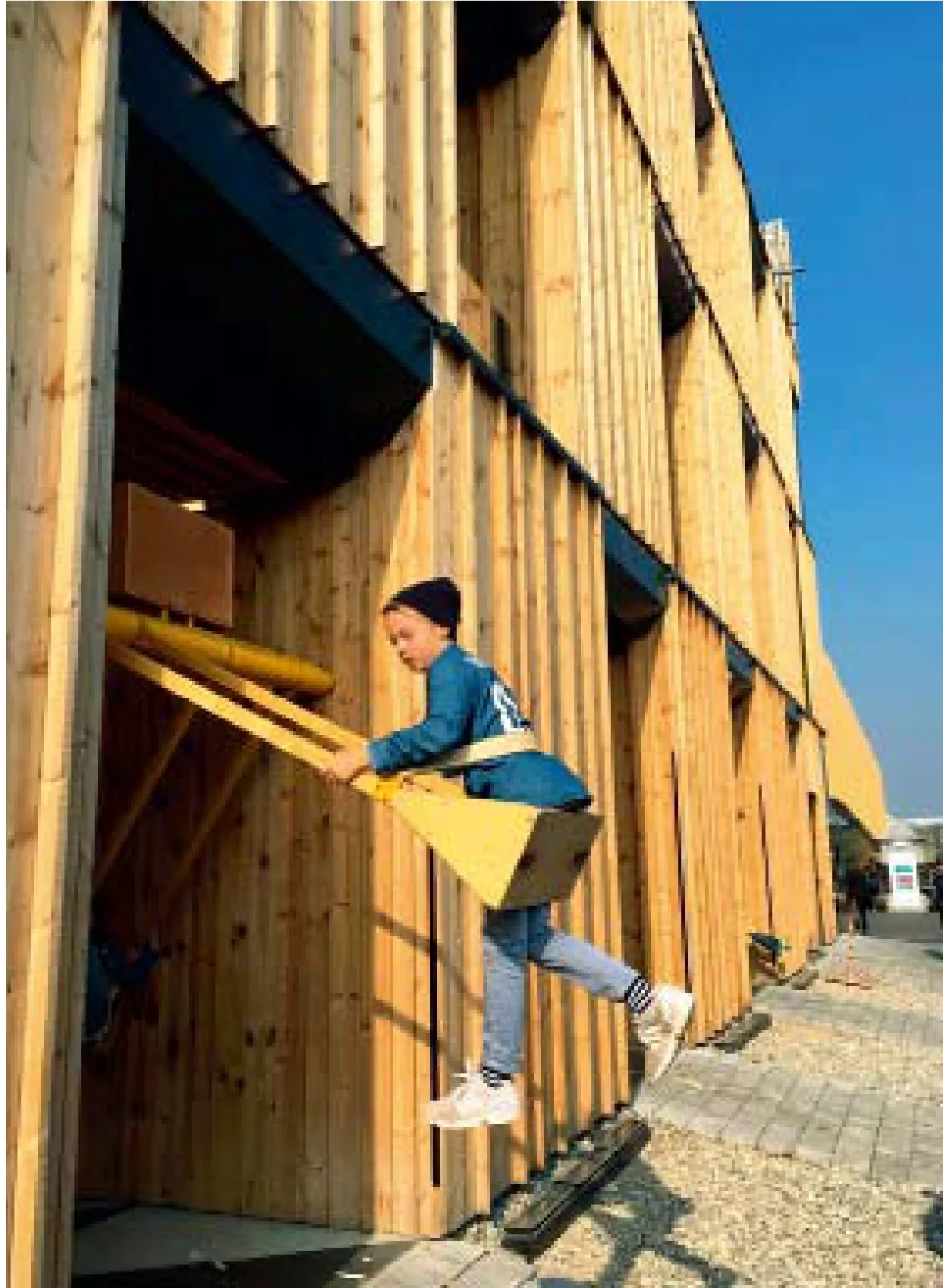
10 外景/Exterior view
评论
苏丹:爱沙尼亚馆努力追求建造的“轻盈”方式,它体现了建造活动和土地友善的态度。形态方面是一个明确地表达了可移动概念的建构,在体量组合方式、材料选用和构造处理方面保持了清晰的逻辑。“轻盈”的另一方面表现在内容的设置和活动的组织上,轻松,得体,令人耳目一新。这种“轻盈”的创造和许多关于农业和食品主题的宏大叙事方式相得益彰。
张璐:这座房子与其说是建筑物,还不如说是木头箱子堆积起来的四面透空的构筑物,这就是米兰世博会的爱沙尼亚馆。与邻居俄罗斯馆不约而同地选择了巨大的悬挑屋顶平台而变得醒目。以全木材质显示其富饶森林资源的在地性,以自由开放的空间显示其活泼好客的民族性。因此名字选择用独特的画廊取代常见的馆,充分诠释了这份国民性格的本真。首层木头盒子里面居然隐藏着一排秋千,从旁边的道路上,会看到一个又一个五颜六色的小朋友从屋子里面荡出来悠回去,令人印象深刻。这份童心成功地使你忘却了这个温润的原木堆砌的国家馆的建筑本身,只记住了阳光般的友善。
Comments
SU Dan: The design pursues a "light-weighted" architectural form, reflecting the environmentalfriendly attitude of construction activities and land use. In morphology, the structure expresses the idea of movability explicitly; and the clear logic can be seen in the pattern of combination of architectural parts in different sizes, choosing various materials, and structural techniques. In addition, the "light-weighted" design is also represented in the content arrangement and the organization of activities in the pavilion with a relaxing and appropriate atmosphere that invokes a refreshed feeling. This "light-weighted" structure complements to the macro narrative on the main themes of agriculture and food.
ZHANG Lu: Instead of being one block of building, this architecture can be considered as a tetrahedral openwork structure piled up with wooden boxes. This is the Estonian Gallery of Milan Expo. Due to the use of a huge cantilevered roof terrace by mere coincidence, both the Estonian Gallery and its neighborhood Russian Pavilion are eye-catching. The full-wooden materials showcase their rich forest resources in the site, and the free and open spaces represent their vivacious and hospitable nationality. Therefore, a unique name, "gallery", is selected by them to use instead of the commonly used "pavilion", which fully illustrates their true national characters. It is impressed that in the wooden boxes on the first floor there is a row of swings hidden inside, and from the view of the adjacent road, you can find many kids in colorful clothes playing swings inside. Thanks to the childlike innocence, you will successfully forget the building itself which is piled up with raw wood of gentle feel into a national pavilion, and brand in mind the sunshine friendliness.

